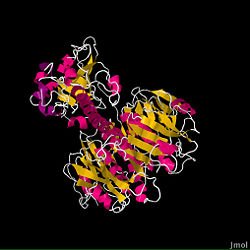User:Caitlin Bell/Sandbox 1
From Proteopedia
(New page: ='''CHOLERA TOXIN'''= ----- ===Introduction=== [[ Image:1XTC.jpg|250px|left| | thumb| 3D image of the Cholera Toxin, which is released by ''Vibrio cholerea''. Subsequent ingestion of the t...) |
|||
| Line 3: | Line 3: | ||
===Introduction=== | ===Introduction=== | ||
[[ Image:1XTC.jpg|250px|left| | thumb| 3D image of the Cholera Toxin, which is released by ''Vibrio cholerea''. Subsequent ingestion of the toxin leads to the Cholera disease. ]] | [[ Image:1XTC.jpg|250px|left| | thumb| 3D image of the Cholera Toxin, which is released by ''Vibrio cholerea''. Subsequent ingestion of the toxin leads to the Cholera disease. ]] | ||
| - | + | Cholera toxin is released by the pathogen ‘’Vibrio cholerae’’ during colonization of the small intestine. The genus ‘Vibrio’ mainly corresponds with saltwater organisms, but there are some freshwater organisms. These organisms use glucose as their main energy and fuel source, and they use flagella for locomotion. | |
| - | + | Cholera is widespread in mainly poverty-stricken areas where food and water environments are unsanitary. After ingestion of ‘’Vibrio cholerae’’, which typically is a result of feces particles in water or food, the cholera toxin is secreted and infects the small intestines, leading to the Cholera disease. Excessive diarrhea and vomiting ensues soon after ingestion, and death can occur within a few hours. Cholera is mainly prevalent in Africa, Asia, and Latin America, leading to 3-5 million cases and 100,000-200,000 deaths every year. | |
| - | + | ||
| - | + | ||
----- | ----- | ||
Revision as of 14:09, 25 April 2011
Contents |
CHOLERA TOXIN
Introduction
Cholera toxin is released by the pathogen ‘’Vibrio cholerae’’ during colonization of the small intestine. The genus ‘Vibrio’ mainly corresponds with saltwater organisms, but there are some freshwater organisms. These organisms use glucose as their main energy and fuel source, and they use flagella for locomotion.
Cholera is widespread in mainly poverty-stricken areas where food and water environments are unsanitary. After ingestion of ‘’Vibrio cholerae’’, which typically is a result of feces particles in water or food, the cholera toxin is secreted and infects the small intestines, leading to the Cholera disease. Excessive diarrhea and vomiting ensues soon after ingestion, and death can occur within a few hours. Cholera is mainly prevalent in Africa, Asia, and Latin America, leading to 3-5 million cases and 100,000-200,000 deaths every year.

